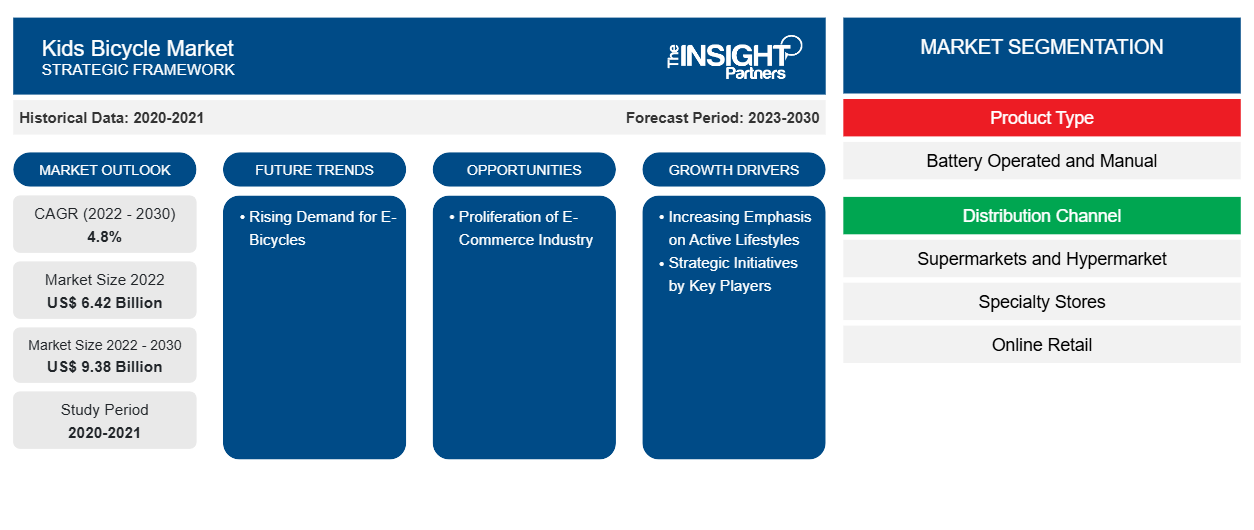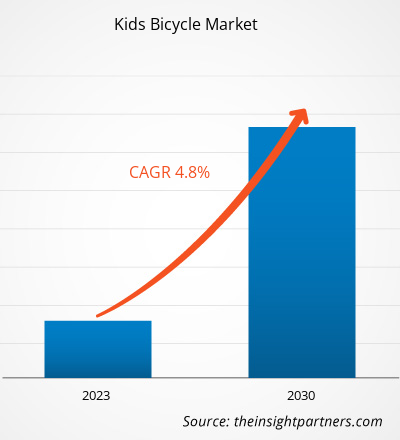[Research Report] The kids bicycle market size is projected to grow from US$ 6,422.81 million in 2022 to US$ 9,379.72 million by 2030; the market is expected to record a CAGR of 4.8% from 2022 to 2030.
Market Insights and Analyst View:
The market is majorly driven by a growing emphasis on an active lifestyle and a surging number of product launches with innovative technologies. Rising awareness regarding childhood obesity and the importance of physical activities has encouraged parents to choose bicycles as a means for their children to stay active. In addition, the rising demand for e-bicycles has further contributed to the kids bicycle market growth.
Growth Drivers and Challenges:
Increasing emphasis on active lifestyles and strategic initiatives by key market players are among the factors contributing to the growing kids bicycle market size. In an ever-evolving industry, companies leverage various strategies to gain a competitive edge, expand their market share, and resonate with their target audience. One prominent strategic initiative is mergers and acquisitions. Companies within the kids bicycle market often merge to consolidate resources, enhance product portfolios, and capitalize on synergies. These strategic moves contribute not only to the growth of individual companies but also to the overall dynamism and competitiveness of the market.
Partnerships and collaborations are also noteworthy strategic initiatives taken by the key players in the kids' bicycle industry. Companies can tap into established networks and leverage existing fan bases by forming alliances with popular brands, entertainment franchises, or educational institutions. Collaborative efforts enable companies to combine their strengths to develop innovative product offerings and effective marketing campaigns that resonate with the preferences of young consumers and their parents. For instance, in November 2023, the Serial 1 e-bike brand, which Harley-Davidson founded, was sold to LEV Manufacturing, Inc., formerly known as Life Electric Vehicles, Inc. Serial 1 will establish e-bike assembly in the US itself, which will lower the price of the bicycles. Serial 1's partnership with LEV Manufacturing ensures its commitment to quality. A dedicated in-house production team in the US will uphold Serial 1's premium e-bike offerings.
The rising demand for e-bicycles has emerged as a kids bicycle market trend, reflecting broader shifts in consumer preferences toward innovative and sustainable transportation solutions for children. E-bicycles, equipped with electric assistance, are gaining popularity due to their ability to offer a unique and exciting riding experience for kids. These bicycles often feature adjustable power levels. Safety is another factor contributing to the rise in demand for e-bicycles in the kids bicycle market. Parents appreciate electric assistance-controlled acceleration and braking capabilities, enhancing the rider's overall safety. This is particularly appealing for parents who may have safety concerns associated with traditional bicycles, as e-bicycles offer additional supervision and control over their child's riding activities.
The environmental consciousness of parents is also influencing the preference for e-bicycles. E-bicycles are perceived as more eco-friendly than traditional bikes, aligning with the growing emphasis on sustainable living. As parents seek ways to instill responsible environmental values in their children, opting for e-bicycles will likely continue its contribute in the kids bicycle market share. Overall, the increasing demand for e-bicycles reflects a convergence of technological innovation, safety considerations, and environmental consciousness, shaping the evolving landscape of kids transportation and recreation.
Safety concerns represent a significant restraint in the kids bicycle market, influencing consumer purchasing decisions and industry dynamics. Parents increasingly prioritize their children's safety during outdoor activities, and bicycles—being a common choice for recreational and transportation purposes—are under scrutiny. One major concern prompting parents to seek bicycles with advanced safety features is the potential for accidents and injuries. This heightened awareness has shifted consumer preferences toward bikes equipped with enhanced braking systems, durable materials, and visibility enhancements to ensure a safer riding experience for children. The fear of accidents and injuries has increased the demand for protective gear such as helmets, knee pads, and elbow pads. While these accessories contribute to child safety, they also add an extra cost for parents. The overall cost of ensuring a safe biking experience, including purchasing safety gear and potentially more expensive bicycles with advanced safety features. Thus, increasing safety concerns impede the kids bicycle market growth.
Customize This Report To Suit Your Requirement
You will get customization on any report - free of charge - including parts of this report, or country-level analysis, Excel Data pack, as well as avail great offers and discounts for start-ups & universities
Kids Bicycle Market: Strategic Insights

-
Get Top Key Market Trends of this report.This FREE sample will include data analysis, ranging from market trends to estimates and forecasts.
Report Segmentation and Scope:
The global kids bicycle market analysis is carried out by considering the following segments - product type, distribution channel, and geography. Based on product type, the market is bifurcated into battery-operated and manual. Based on distribution channel, the kids bicycle market is segmented into supermarkets and hypermarkets, specialty stores, online retail, and others. The scope of the kids bicycle market report includes North America (the US, Canada, and Mexico), Europe (Germany, France, Italy, the UK, Russia, and the Rest of Europe), Asia Pacific (Australia, China, Japan, India, South Korea, and the Rest of Asia Pacific), the Middle East & Africa (South Africa, Saudi Arabia, the UAE, and the Rest of Middle East & Africa), and South & Central America (Brazil, Argentina, and the Rest of South & Central America).
Segmental Analysis:
Based on product type, the kids bicycle market is bifurcated into battery-operated and manual. The manual segment is anticipated to hold a significant kids market share by 2030. The manual segment of the market comprises traditional bicycles that rely on the physical effort of the rider to move them forward. These bicycles come in various sizes and designs, catering to different age groups and skill levels. Manual bicycles are fundamental for teaching children essential motor skills, balance, and coordination. Parents often opt for these classic bicycles as they offer a timeless and physically engaging way for kids to enjoy outdoor activities while contributing to their overall development.
Regional Analysis:
The kids bicycle market is segmented into five key regions—North America, Europe, Asia Pacific, South & Central America, and the Middle East & Africa. In terms of revenue, Asia Pacific dominated the kids bicycle market share; the market in this region was valued at US$ 2,167.70 million in 2022. North America is the second major contributor to the market, which holds ~28% of the global market. North America is witnessing increasing demand for kids' bicycles owing to rising awareness of childhood obesity. A growing emphasis on promoting a healthy and active lifestyle for children is being driven by increasing awareness of childhood obesity and sedentary behavior. As parents and caretakers prioritize physical activity, the demand for bicycles as a means of exercise and outdoor recreation for children has risen. Cycling burns calories, promotes fitness, and builds muscle and coordination, making it a fun and effective tool for healthy development.
The COVID-19 pandemic has also played a role in rising demand for kids bicycles. With lockdowns and restrictions limiting various outdoor sports and recreational activities, parents sought alternative ways to keep their children engaged and active. Bicycling emerged as a safe and enjoyable outdoor activity where kids can enjoy and be active while maintaining social distancing. This factor contributed to the heightened demand for kids' bicycles. For the past two decades, the Corvallis School District (CSD) in Oregon, US has encouraged students to walk and bike to school. All fifth-grade students participate in a weeklong bicycle safety class, which is expected to be soon expanded to include other grades. Under the Safe Routes to School (SRTS) programs, parents, schools, community leaders, and local, state, and federal governments are enabling and encouraging the walk and bicycling to schools to improve the health and well-being of children.
Asia Pacific is home to 60% of the world's population, nearly 4.3 billion people, and includes the world's most populous countries, China and India. With a rising emphasis on promoting healthy lifestyles for children and a growing middle-class population, the demand for kids bicycles has witnessed significant traction in recent years. In countries such as China and India, where urbanization and changing lifestyles are prominent, there is a heightened awareness among parents about the importance of outdoor activities for children. This awareness has translated into an increased demand for kids bicycles as a means to encourage physical activity and provide a mode of recreation.
Kids Bicycle Market Regional InsightsThe regional trends and factors influencing the Kids Bicycle Market throughout the forecast period have been thoroughly explained by the analysts at The Insight Partners. This section also discusses Kids Bicycle Market segments and geography across North America, Europe, Asia Pacific, Middle East and Africa, and South and Central America.
Kids Bicycle Market Report Scope
| Report Attribute | Details |
|---|---|
| Market size in 2022 | US$ 6.42 Billion |
| Market Size by 2030 | US$ 9.38 Billion |
| Global CAGR (2022 - 2030) | 4.8% |
| Historical Data | 2020-2021 |
| Forecast period | 2023-2030 |
| Segments Covered |
By Product Type
|
| Regions and Countries Covered |
North America
|
| Market leaders and key company profiles |
|
Kids Bicycle Market Players Density: Understanding Its Impact on Business Dynamics
The Kids Bicycle Market is growing rapidly, driven by increasing end-user demand due to factors such as evolving consumer preferences, technological advancements, and greater awareness of the product's benefits. As demand rises, businesses are expanding their offerings, innovating to meet consumer needs, and capitalizing on emerging trends, which further fuels market growth.

- Get the Kids Bicycle Market top key players overview
Industry Developments and Future Opportunities:
Various initiatives taken by key players operating in the kids bicycle market are listed below:
- In 2021, Specialized Bicycle Components Inc. introduced the Jett, an adjustable kid's bike designed to promote a lifetime of riding. The bike is perfectly proportional and child-liftable, making it ideal for roads and neighborhoods.
- In 2023, Paco Bike Co Ltd launched a number of new models, which comprise 20" Racing Road Bike, 24" Pro Road Bike Disc, and 26" Prorace CX Disc.
- In July 2023, ToysRus announced its plan to reintroduce its exclusive collection of children's bicycles. The company specializes in toys for children of various ages, providing everything from simple toys to large, complex ones. They personalize bicycles with superheroes and Disney princesses to attract children's attention and increase sales.
Competitive Landscape and Key Companies:
SCOTT Sports SA, Cycling Sports Group Inc, GT Bicycles LLC, Merida Industry Co Ltd, BikeCo LLC, Kona Bicycle Co, Paco Bike Co Ltd, Specialized Bicycle Components Inc, Trek Bicycle Corp, and Giant Manufacturing Co Ltd are key players profiled in the kids bicycle market report. These market players are adopting strategic development initiatives to expand, further driving the market growth.
Frequently Asked Questions
Can you list some of the major players operating in the global kids bicycle market?
Based on the product type, why is the oil segment have the largest revenue share?
What are the key drivers for the growth of the global kids bicycle market?
What are the opportunities for kids bicycle in the global market?
Based on the distribution channel, which segment is projected to grow at the fastest CAGR over the forecast period?
What is the largest region of the global kids bicycle market?
- Historical Analysis (2 Years), Base Year, Forecast (7 Years) with CAGR
- PEST and SWOT Analysis
- Market Size Value / Volume - Global, Regional, Country
- Industry and Competitive Landscape
- Excel Dataset
Recent Reports
Testimonials
Reason to Buy
- Informed Decision-Making
- Understanding Market Dynamics
- Competitive Analysis
- Identifying Emerging Markets
- Customer Insights
- Market Forecasts
- Risk Mitigation
- Boosting Operational Efficiency
- Strategic Planning
- Investment Justification
- Tracking Industry Innovations
- Aligning with Regulatory Trends





















 Get Free Sample For
Get Free Sample For